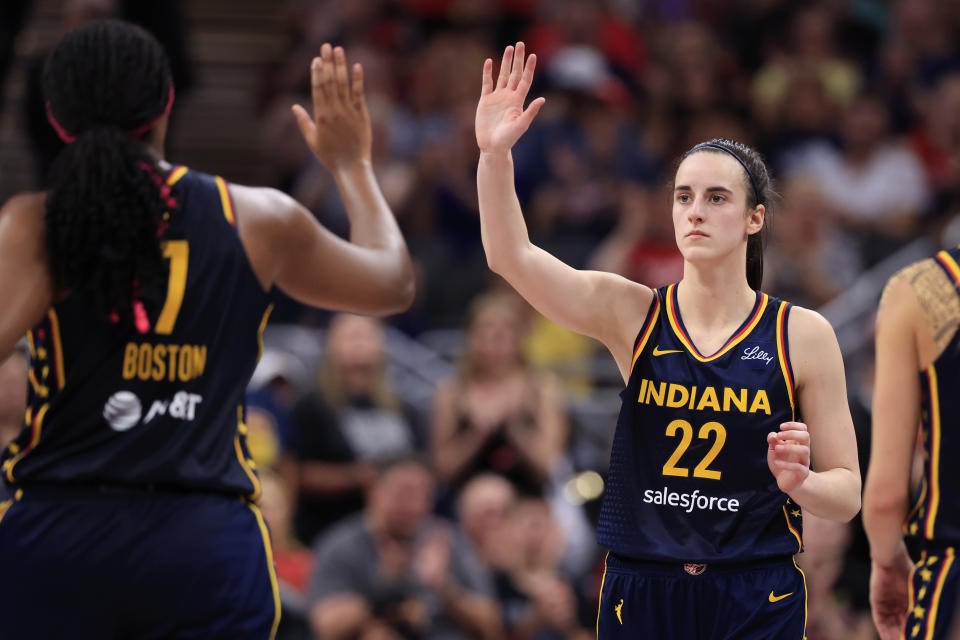There’s one thing I got wrong (or at least vastly underestimated) about Caitlin Clark’s impact on the WNBA. There’s also one thing I think almost everyone got wrong about the WNBA’s reaction to Caitlin Clark and her impact on the league.
The WNBA playoffs begin Sunday, with Clark’s Indiana Fever scheduled to face the Connecticut Sun in a best-of-three series.
The league has historically struggled to garner ratings or attention outside of hardcore fans, especially when faced with competition from pro and college football. Last year’s playoffs averaged just 728,000 viewers on ESPN — actually up more than 30 percent, but still a paltry number. The playoffs overall averaged just 470,000 viewers.
Not this time.
This is the Clark factor I didn’t see coming.
Would her arrival, after a legendary and legendarily popular career at the University of Iowa, bring more attention and new fans? Absolutely. Clark is one of the most popular athletes in the United States. Television ratings, media attention, jersey sales, etc., were all going to skyrocket.
That said, interest in one level of the sport doesn’t always equate to interest in the next level, or a different level. The U.S. Women’s National Soccer Team has emerged from World Cups and Olympic gold medals with plenty of momentum and mega-famous stars — Alex Morgan, Hope Solo, Carli Lloyd, etc. However, the impact on the National Women’s Soccer League has been a rebound, not a sustained surge.
While Clark’s style of play was a crowd-pleaser, he also benefited from some built-in factors.
First, Iowa has a much larger fan base than any WNBA team, so it didn’t need to create a Hawkeyes fan base when it came to Des Moines; it just needed to get a larger percentage of Hawkeyes fans interested in women’s basketball. Second, most of its biggest games were against equally (or even more) popular teams: Ohio State, Indiana, Connecticut, LSU, South Carolina, etc.
Clark and Iowa became an event wherever they went. That’s different from what happens every night.
Then there was the NCAA Tournament draw: the brackets, the home-and-away, the time in March/April when the country focuses on basketball. The women’s Final Four always trumps the WNBA.
The 2024 national title game between Iowa and South Carolina drew a staggering 18.9 million viewers, but how many of them would follow Clark through an extended WNBA regular season without the drama of March Madness? Would they watch any boring July games?
Well, many of them did. The WNBA’s ratings growth this year was almost unimaginable.
ESPN reports it averaged 1.2 million viewers for its games, up from 440,000 the year before. By comparison, the NBA’s average rating last season for games on ESPN and TNT was 1.56 million. About 3.44 million watched the WNBA All-Star Game versus 5.5 million for the NBA All-Star Game.
The Fever alone accumulated five games with more than two million viewers and 18 with more than one million. And this did not only happen on Sunday afternoons on ABC.
The Friday, Aug. 30 game against Chicago drew 1.6 million viewers to Ion, easily the largest audience in the discrete cable network’s history. Two games on NBATV recorded 600,000 or more viewers.
Clark’s fans came and didn’t leave. They followed every game. Some of them, no doubt, started watching other teams, too. Yes, Clark was the main attraction, but more people know about the brilliance of A’ja Wilson and Breanna Stewart today than they did a year ago.
This suggests that while the Fever’s playoff ratings could set new records, there may be a sustained, extended push for all postseason games that goes far beyond any reasonable expectations (mine in particular) of what Clark was going to deliver.
Now, the part that seemed to concern the league and many of its fans. Clark demanded enormous attention and sold-out crowds wherever he went. With that came understandable resentment from returning players and many longtime fans.
There was endless complaining about how WNBA players and coaches should embrace and thank Clark for what she was doing for the league. But having so many pushbacks (or sometimes literally being torn down) made the league even more interesting.
The best thing that happened to everyone was the indifference and harsh fouls, the Olympic “snub” and the seeming dismissal by Sheryl Swoopes and the TV commentators. The more Clark was fired up, the more reason her fans (and all fans) had to tune in to see how she responded.
Rivalries are great for sports. Controversies sell. Had Clark been embraced, accepted and heralded, the 2024 season would have lacked the spice that has made it an even more intriguing event.
Clark slowly adapted to the physicality of the WNBA as her teammates adjusted to her style of play. She enters the playoffs as one of the league’s top five players and now regularly scores 25 to 30 points per game while knocking down three-pointers and throwing passes the length of the court. That’s what attracted so many people to her in the first place.
No, there probably won’t be a playoff game that reaches 18.9 million viewers, but Caitlin Clark has not only surpassed the levels of popularity expected as a rookie, the resilience surrounding her and her success has helped her in that quest.
The first game will be played on Sunday, against the NFL. This time, a lot of people will be watching it anyway.


